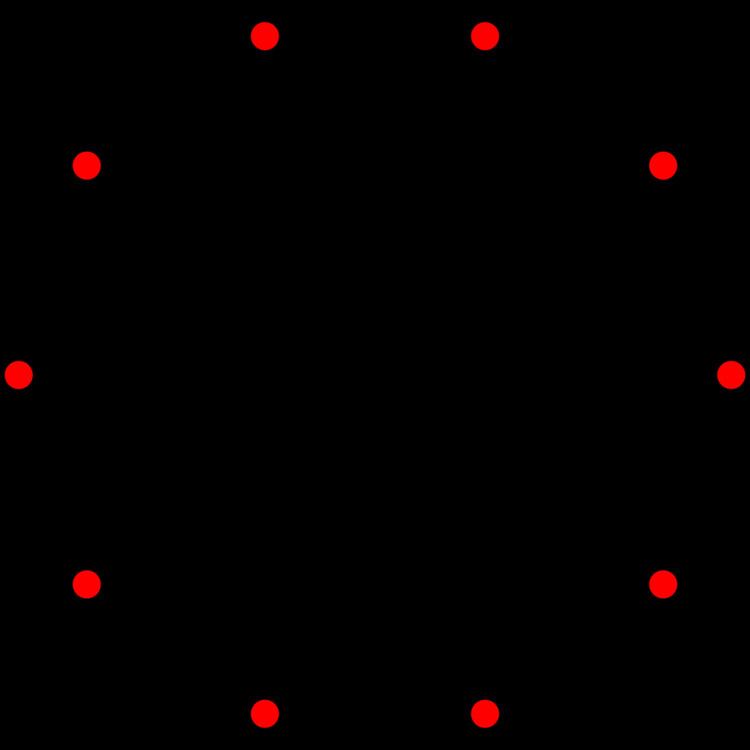 | ||
In nine-dimensional geometry, a nine-dimensional polytope or 9-polytope is a polytope contained by 8-polytope facets. Each 7-polytope ridge being shared by exactly two 8-polytope facets.
Contents
- Regular 9 polytopes
- Euler characteristic
- Uniform 9 polytopes by fundamental Coxeter groups
- The A9 family
- The B9 family
- The D9 family
- Regular and uniform honeycombs
- Regular and uniform hyperbolic honeycombs
- References
A uniform 9-polytope is one which is vertex-transitive, and constructed from uniform 8-polytope facets.
Regular 9-polytopes
Regular 9-polytopes can be represented by the Schläfli symbol {p,q,r,s,t,u,v,w}, with w {p,q,r,s,t,u,v} 8-polytope facets around each peak.
There are exactly three such convex regular 9-polytopes:
- {3,3,3,3,3,3,3,3} - 9-simplex
- {4,3,3,3,3,3,3,3} - 9-cube
- {3,3,3,3,3,3,3,4} - 9-orthoplex
There are no nonconvex regular 9-polytopes.
Euler characteristic
The topology of any given 9-polytope is defined by its Betti numbers and torsion coefficients.
The value of the Euler characteristic used to characterise polyhedra does not generalize usefully to higher dimensions, whatever their underlying topology. This inadequacy of the Euler characteristic to reliably distinguish between different topologies in higher dimensions led to the discovery of the more sophisticated Betti numbers.
Similarly, the notion of orientability of a polyhedron is insufficient to characterise the surface twistings of toroidal polytopes, and this led to the use of torsion coefficients.
Uniform 9-polytopes by fundamental Coxeter groups
Uniform 9-polytopes with reflective symmetry can be generated by these three Coxeter groups, represented by permutations of rings of the Coxeter-Dynkin diagrams:
Selected regular and uniform 9-polytopes from each family include:
- {38} - 9-simplex or deca-9-tope or decayotton -
- {4,37} - 9-cube or enneract -
- {37,4} - 9-orthoplex or enneacross -
- {31,6,1} - 9-demicube or demienneract, 161 - ; also as h{4,38} .
- {36,1,1} - 9-orthoplex, 611 -
The A9 family
The A9 family has symmetry of order 3628800 (10 factorial).
There are 256+16-1=271 forms based on all permutations of the Coxeter-Dynkin diagrams with one or more rings. These are all enumerated below. Bowers-style acronym names are given in parentheses for cross-referencing.
The B9 family
There are 511 forms based on all permutations of the Coxeter-Dynkin diagrams with one or more rings.
Eleven cases are shown below: Nine rectified forms and 2 truncations. Bowers-style acronym names are given in parentheses for cross-referencing. Bowers-style acronym names are given in parentheses for cross-referencing.
The D9 family
The D9 family has symmetry of order 92,897,280 (9 factorial × 28).
This family has 3×128−1=383 Wythoffian uniform polytopes, generated by marking one or more nodes of the D9 Coxeter-Dynkin diagram. Of these, 255 (2×128−1) are repeated from the B9 family and 128 are unique to this family, with the eight 1 or 2 ringed forms listed below. Bowers-style acronym names are given in parentheses for cross-referencing.
Regular and uniform honeycombs
There are five fundamental affine Coxeter groups that generate regular and uniform tessellations in 8-space:
Regular and uniform tessellations include:
Regular and uniform hyperbolic honeycombs
There are no compact hyperbolic Coxeter groups of rank 9, groups that can generate honeycombs with all finite facets, and a finite vertex figure. However, there are 4 noncompact hyperbolic Coxeter groups of rank 9, each generating uniform honeycombs in 8-space as permutations of rings of the Coxeter diagrams.
